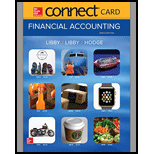
Connect Access Card for Financial Accounting
9th Edition
ISBN: 9781259738678
Author: Robert Libby, Patricia Libby, Frank Hodge Ch
Publisher: McGraw-Hill Education
expand_more
expand_more
format_list_bulleted
Textbook Question
Chapter 13, Problem 13.3AP
Calculating Profitability, Turnover, Liquidity, Solvency, and Market Ratios (P13-3)
Using the financial information presented in Exhibit 13.1, calculate the following ratios for The Home Depot:
- Net profit margin
- Earnings quality
- Receivable turnover
- Cash ratio
- Times interest earned
- Price/earnings ratio (assume a market price per share of $100)
Expert Solution & Answer
Want to see the full answer?
Check out a sample textbook solution
Students have asked these similar questions
Goodwill is an example of an indefinite-life intangible asset, meaning that public companies must test it for impairment rather than regularly amortizing to systematically reduce its value on the balance sheet of the public company.
Can anyone recap the difference between limited-life versus indefinite-life intangible assets? Any specific examples of either category?
Why are adjusting journal entries necessary at the end of an accounting period? Need he
Why are adjusting journal entries necessary at the end of an accounting period?i need help
Chapter 13 Solutions
Connect Access Card for Financial Accounting
Ch. 13 - Who are the primary users of financial statements?Ch. 13 - When considering an investment in stock, investors...Ch. 13 - How does product differentiation differ from cost...Ch. 13 - What are the two general methods for making...Ch. 13 - What are component percentages? Why are they...Ch. 13 - What is ratio analysis? Why is it useful?Ch. 13 - What do profitability ratios focus on? What is an...Ch. 13 - What do turnover ratios focus on? What is an...Ch. 13 - What do liquidity ratios focus on? What is an...Ch. 13 - What do solvency ratios focus on? What is an...
Ch. 13 - What do market ratios focus on? What is an example...Ch. 13 - Prob. 12QCh. 13 - Explain why rapid growth in total sales might not...Ch. 13 - A company has total assets of 500,000 and...Ch. 13 - Prob. 2MCQCh. 13 - Prob. 3MCQCh. 13 - Prob. 4MCQCh. 13 - Prob. 5MCQCh. 13 - Prob. 6MCQCh. 13 - Prob. 7MCQCh. 13 - Prob. 8MCQCh. 13 - Prob. 9MCQCh. 13 - Prob. 10MCQCh. 13 - Prob. 13.1MECh. 13 - Prob. 13.2MECh. 13 - Prob. 13.3MECh. 13 - Computing the Financial Leverage Percentage...Ch. 13 - Analyzing the Inventory Turnover Ratio A...Ch. 13 - Prob. 13.6MECh. 13 - Prob. 13.7MECh. 13 - Prob. 13.8MECh. 13 - Prob. 13.9MECh. 13 - Prob. 13.10MECh. 13 - Using Financial Information to Identify Companies...Ch. 13 - Prob. 13.2ECh. 13 - Prob. 13.3ECh. 13 - Prob. 13.4ECh. 13 - Prob. 13.5ECh. 13 - Prob. 13.6ECh. 13 - Prob. 13.7ECh. 13 - Prob. 13.8ECh. 13 - Prob. 13.9ECh. 13 - Prob. 13.10ECh. 13 - Inferring Financial Information from Ratios E13-11...Ch. 13 - Prob. 13.12ECh. 13 - Prob. 13.13ECh. 13 - Prob. 13.1PCh. 13 - Prob. 13.2PCh. 13 - Prob. 13.3PCh. 13 - Prob. 13.4PCh. 13 - Prob. 13.5PCh. 13 - Computing Comparative Financial Statements and...Ch. 13 - Analyzing Financial Statements Using Ratios Use...Ch. 13 - Prob. 13.8PCh. 13 - Prob. 13.9PCh. 13 - Prob. 13.1APCh. 13 - Prob. 13.2APCh. 13 - Calculating Profitability, Turnover, Liquidity,...Ch. 13 - Prob. 13.4APCh. 13 - Prob. 13.5APCh. 13 - Prob. 13.6APCh. 13 - Prob. 13.1CPCh. 13 - Prob. 13.2CPCh. 13 - Comparing Companies within an Industry Refer to...Ch. 13 - Prob. 13.4CPCh. 13 - Inferring Information from the DuPont Model Ratios...Ch. 13 - Prob. 13.6CP
Knowledge Booster
Learn more about
Need a deep-dive on the concept behind this application? Look no further. Learn more about this topic, accounting and related others by exploring similar questions and additional content below.Similar questions
arrow_back_ios
SEE MORE QUESTIONS
arrow_forward_ios
Recommended textbooks for you
 Intermediate Financial Management (MindTap Course...FinanceISBN:9781337395083Author:Eugene F. Brigham, Phillip R. DavesPublisher:Cengage Learning
Intermediate Financial Management (MindTap Course...FinanceISBN:9781337395083Author:Eugene F. Brigham, Phillip R. DavesPublisher:Cengage Learning College Accounting, Chapters 1-27AccountingISBN:9781337794756Author:HEINTZ, James A.Publisher:Cengage Learning,
College Accounting, Chapters 1-27AccountingISBN:9781337794756Author:HEINTZ, James A.Publisher:Cengage Learning, Managerial Accounting: The Cornerstone of Busines...AccountingISBN:9781337115773Author:Maryanne M. Mowen, Don R. Hansen, Dan L. HeitgerPublisher:Cengage Learning
Managerial Accounting: The Cornerstone of Busines...AccountingISBN:9781337115773Author:Maryanne M. Mowen, Don R. Hansen, Dan L. HeitgerPublisher:Cengage Learning

Intermediate Financial Management (MindTap Course...
Finance
ISBN:9781337395083
Author:Eugene F. Brigham, Phillip R. Daves
Publisher:Cengage Learning


College Accounting, Chapters 1-27
Accounting
ISBN:9781337794756
Author:HEINTZ, James A.
Publisher:Cengage Learning,

Managerial Accounting: The Cornerstone of Busines...
Accounting
ISBN:9781337115773
Author:Maryanne M. Mowen, Don R. Hansen, Dan L. Heitger
Publisher:Cengage Learning
Financial ratio analysis; Author: The Finance Storyteller;https://www.youtube.com/watch?v=MTq7HuvoGck;License: Standard Youtube License